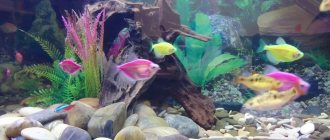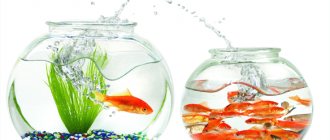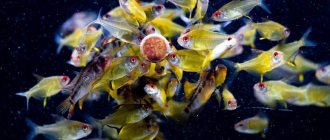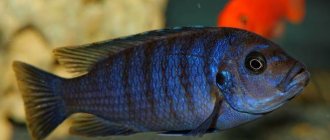Attention! The calculator calculates the most optimal conditions for keeping fish in the most comfortable conditions for them. You can slightly increase the number of fish, provided that you either have excellent water filtration, or regularly change it with a soil siphon, or have a lot of fast-growing plants that absorb trace elements and nitrates from the water, or a combination of these factors.
Beginner aquarists complain that the calculator has too large volumes, but understand one thing, if you do not trust the calculation result, then in the future you will have to deal with algae (beard, flip flop, filament, xenococus), fish diseases (semolina, bloating, ruffled scales , various infections and fungi) and other troubles (white worms).
When calculating the quantity, be sure to take into account the size of adults, and not young animals or fry, and the characteristics of their behavior, fast or slow, love shelters and thickets or open space, etc. And only based on this, calculate the number of fish you like. How to do this correctly? Let's find out below.
What is the threat of overpopulation?
If there is overcrowding in the bank, the fish will begin to suffer from a lack of oxygen, which will negatively affect their health. In addition, a struggle for living space will begin, which can lead to damaged fins.
Large fish release a lot of waste into the water, which leads to an increase in ammonia, nitrates and nitrites. Because of this, pets can die.
Of course, you can install a powerful external filter in an overpopulated aquarium, change water more frequently, and plant a lot of plants. In this case, the fish will not be poisoned and die. But will they be comfortable? Of course not. And you are unlikely to like an aquarium densely populated with fish.
How to care for a small round aquarium?
Small round aquarium care
So, we have actually figured out the maintenance of a small aquarium. The above rules will allow you to recreate a stable biological system even in the tiniest aquarium.
However, the issue of caring for such a reservoir is no less important. We've already gone crazy with water changes - we don't drain all the water, we only do a partial water change.
We also recommend that you never remove or wash the laid aquarium soil. Unfortunately, many people often do this. Such actions kill all useful biology in the soil. Do not touch the bottom of the aquarium for as long as possible - until it is obvious that detritus (organic-inorganic particles that accumulate in the soil and do not participate in the biological cycle for one reason or another) has significantly filled the aquarium soil, thereby reducing soil aeration . When this happens, just walk over the ground with a mini-siphon, which you can buy, or you can make it yourself using improvised means (Google it).
As for the walls of the aquarium, yes, they can become overgrown with various organisms even in a week. Every week before changing the water, just run a toothbrush along the walls of the aquarium and that’s it. When changing water, use fresh water that has stood for 24 hours.
Any person who respects himself and his aquarium should always have aquarium water tests . For this type of aquarium, we recommend using test strips, for example, Tetra 6 in 1 - this, in our opinion, will be sufficient and less troublesome. But, of course, drop tests can also be used.
Calculation of the number of fish in the aquarium
There are different methods of counting, modern and those used in the old fashioned way. We will introduce you to all the methods, including incorrect ones, and tell you their disadvantages.
Method 1
Most often, novice aquarists are asked to calculate the number of fish based on their length. In this case, 1-2 liters of water per 1 cm of pets. This calculation is outdated and not very correct. I'll explain why. Following this calculation, a 100 liter aquarium can be stocked with 10 goldfish about 10 cm in size. Goldfish release a lot of waste into the water, which will be difficult for even a powerful external filter to cope with. Over time, the owner of such a jar will face the death and illness of pets. Imagine 4 adult 25 cm astronotuses in a 100 liter container. There will be nowhere for them to turn around. That is, this formula does not work correctly.
Method 2
No less popular is the method according to which 1 fish should have 5 liters of water. But again, it does not take into account the size of the fish. It can only be used for non-aggressive medium-sized fish, like barbs or even smaller.
Method 3
It would be more correct to determine the number of pets according to the rule “3.5 cm per 5 liters of water.” In this case, 3.5 cm is the length of all the inhabitants of the aquarium. When using this rule, you should consider:
- Maximum adult size.
- The form of purchased pets. Fat fish produce more waste than slender and elongated fish (for example, gourami and mollies, platies and zebrafish). This means that the displacement per full fish should be greater than that per elongated fish.
- The actual volume of water in the aquarium will be approximately 15% less than when empty. This 15% will be taken up by the soil, not filling up to the top, plants and other decorative elements.
Method 4
Now let's look at calculating the number of fish by water surface area. To calculate the area, the length of the container is multiplied by the width. The larger the area, the more oxygen in the water and the more fish you can put in the jar. For large, plump fish species, a ratio of 150 cm² of surface area for every 3 cm of body length is considered comfortable, and for slender fish , for every 3 cm of length there is 90 cm² of surface area. When calculating the number of pets using this method, you must leave a small reserve.
- Full: for every 3 cm – 150 cm².
- Slender: for every 3 cm – 90 cm².
Calculation example: an aquarium 100cm long and 45cm wide. The resulting area is 100 x 45 = 4500 cm². We are planning 6-centimeter full fish , that is, 300 cm² per fish (150 cm² per 3 cm of length - that means 300 cm² per 6-centimeter fish). We get 4500 / 300 = 15 fish. Accordingly, 4500 / 180 = 25 pieces for slender and elongated 6-centimeter fish. Don't forget to leave a small margin, say 10%.
Number of liters for certain fish
Some aquarists shared their experience of keeping fish in an aquarium and told what type of fish and how many liters of water are needed. All of the tips listed below are given for jars that are regularly maintained and have a filter.
- Small aquarium fish up to 4 cm in size (guppies, neon, rasbor) are kept in containers of 20 liters or more. In this case, 1 individual should have at least 1 liter of water, but more is better.
- For fish up to 6 cm long (platies, minors, thornets), the minimum stocking density is 2 liters per individual.
- For peaceful aquarium fish up to 10 cm long (swordtails, barbs, mollies, apistograms) you will need an aquarium with a volume of at least 50 liters. Planting density is from 10 to 15 liters per individual.
- Labyrinth fish are placed in an aquarium depending on their size. For example, one betta will be comfortable in a 20 liter aquarium. A pair of marble and gold gourami should account for 30 liters. The quantity of honey and chocolate gourami is calculated based on the rule of 10-15 liters per couple.
- Discus fish need an aquarium of at least 200 liters to live comfortably. Only 2 fish can live in such a container.
- One goldfish, ancistrus and angelfish should have 50 liters of water. Only in a spacious aquarium will they feel comfortable.
- Large catfish measuring 30-40 cm are kept in spacious jars with a capacity of 200 liters or more.
- For large fish such as arawana, snakehead, flower horn, Indian knife, you will need a 500 liter container.
Aquariums 100 liters
A 100 liter aquarium is an excellent solution for an aquarium in a children's room. This small-sized aquarium can house schooling small fish, which are ideal for children as a pet: such fish are unpretentious, but they are bright and active, which children will definitely like. The 100 liter aquarium is easy to clean, and you can cope with the planned cleaning procedures of the aquarium yourself.
Rectangular aquarium Rekord 600
Size: 610 mm x 310 mm x 420 mm detailed description
Aquarium cost: 10,200 rubles
Rectangular aquarium 60 l Biodesign Reef
Size: 530 mm x 310 mm x 420 mm Glass thickness: 4 mm detailed description
Cost of the aquarium: from 5,500 rubles
Rectangular aquarium Rekord 700
Size: 610 mm x 310 mm x 465 mm detailed description
Cost of the aquarium: 11,500 rubles
Rectangular aquarium 80 l Biodesign Reef
Size: 700 mm x 320 mm x 460 mm Glass thickness: 6 mm detailed description
Cost of the aquarium: from 7,000 rubles
Rectangular aquarium Aquatlantis Aquadream 80
Size: 800 mm x 300 mm x 450 mm detailed description
Cost of the aquarium: from 13,900 rubles
Rectangular aquarium Aquatlantis Elegance Plus 58
Size: 580 mm x 380 mm x 550 mm detailed description
Cost of the aquarium: from 16,950 rubles
Rectangular aquarium 100 l Biodesign Reef
Size: 550 mm x 450 mm x 500 mm Glass thickness: 5 mm detailed description
Cost of the aquarium: from 8,100 rubles
Rectangular aquarium Rekord 800
Size: 810 mm x 360 mm x 450 mm detailed description
Cost of the aquarium: RUB 14,700
Rectangular aquarium Aquatlantis Fusion 60
Size: 600 mm x 400 mm x 600 mm detailed description
Cost of the aquarium: from 33,400 rubles
Rectangular aquarium Aquatlantis Aquadream 100
Size: 1000 mm x 300 mm x 450 mm detailed description
Cost of the aquarium: from RUB 24,650
Rectangular aquarium Lido 120
Size: 610 mm x 410 mm x 580 mm detailed description
Cost of the aquarium: 21,400 rubles
Rectangular aquarium Rio 125
Size: 810 mm x 360 mm x 500 mm detailed description
Cost of the aquarium: 16,800 rubles
Rectangular aquarium 125 l Biodesign Reef
Size: 800 mm x 370 mm x 520 mm Glass thickness: 6 mm detailed description
Cost of the aquarium: from 9,100 rubles
Rectangular aquarium Aquatlantis Evasion 80×40
Size: 800 mm x 400 mm x 500 mm detailed description
Cost of the aquarium: from 24,700 rubles
Rectangular aquarium Aquatlantis Fusion 80
Size: 800 mm x 400 mm x 550 mm detailed description
Cost of the aquarium: from 34,000 rubles
Rectangular aquarium Aquatlantis Elegance Plus 78
Size: 780 mm x 380 mm x 550 mm detailed description
Cost of the aquarium: from 18,800 rubles
Rectangular aquarium Aquatlantis Ambiance 60
Size: 600 mm x 400 mm x 550 mm detailed description
Cost of the aquarium: from 22,250 rubles
Rectangular aquarium Aquatlantis Prestige 130
Size: 750 mm x 360 mm x 700 mm detailed description
Cost of the aquarium: from 21,000 rubles
Rectangular aquarium ARG 150 liters
Size: 840 mm x 390 mm x 510 mm Glass thickness: 6 mm detailed description
Cost of the aquarium: from 9,200 rubles
Rectangular aquarium 150 l Biodesign Reef
Size: 850 mm x 400 mm x 500 mm Glass thickness: 6 mm detailed description
Cost of the aquarium: from 10,400 rubles
Rectangular aquarium Aquatlantis Evasion 56×56
Size: 560 mm x 560 mm x 600 mm detailed description
Cost of the aquarium: from 30,000 rubles
Rectangular aquarium Aquatlantis Ambiance 80
Size: 800 mm x 400 mm x 500 mm detailed description
Cost of the aquarium: from RUB 22,800
Rectangular aquarium Aquatlantis Elegance Plus 100
Size: 1000 mm x 380 mm x 600 mm detailed description
Cost of the aquarium: from RUB 23,450
Panoramic aquarium 60 l Biodesign Panorama
Size: 550 mm x 310 mm x 440 mm Glass thickness: 5-6 mm detailed description
Cost of the aquarium: from 6,900 rubles
Panoramic aquarium 80 l Biodesign Panorama
Size: 700 mm x 320 mm x 460 mm Glass thickness: 6 mm detailed description
Cost of the aquarium: from 8,100 rubles
Panoramic aquarium 100 l Biodesign Panorama
Size: 700 mm x 350 mm x 500 mm Glass thickness: 5-6 mm detailed description
Cost of the aquarium: from 10,150 rubles
Panoramic aquarium ARG 140 liters
Size: 840 mm x 390 mm x 510 mm Glass thickness: 6 mm detailed description
Cost of the aquarium: from 10,500 rubles
Panoramic aquarium with curved front glass ARG 150 liters
Size: 840 mm x 390 mm x 510 mm Glass thickness: 6 mm detailed description
Cost of the aquarium: from 13,400 rubles
Panoramic aquarium 150 l Biodesign Panorama
Size: 850 mm x 400 mm x 500 mm Glass thickness: 6 mm detailed description
Cost of the aquarium: from 12,350 rubles
Panoramic aquarium Aquatlantis Ambiance Horizon 100
Size: 1010 mm x 400 mm x 560 mm detailed description
Cost of the aquarium: from RUB 37,200
Corner aquarium 70 l Biodesign Diarama
Size: 500 mm x 500 mm x 500 mm Glass thickness: 5-6 mm detailed description
Cost of the aquarium: from 8,600 rubles
Corner aquarium 100 l Biodesign Laguna
Size: 450 mm x 450 mm x 600 mm Glass thickness: 5-6 mm detailed description
Cost of the aquarium: from 8,800 rubles
Corner aquarium with curved front glass ARG 100 liters
Size: 700mm x 710mm x 500mm Glass thickness: 6mm detailed description
Cost of the aquarium: from RUB 15,500
Corner aquarium ARG 150 liters
Size: 610mm x 610mm x 510mm Glass thickness: 6mm detailed description
Cost of the aquarium: from 10,500 rubles
Corner aquarium 150 l Biodesign Diarama
Size: 600 mm x 600 mm x 500 mm Glass thickness: 6 mm detailed description
Cost of the aquarium: from 13,400 rubles
Corner aquarium Aquatlantis Ambiance Corner 100
Size: 1000 mm x 750 mm x 600 mm detailed description
Cost of the aquarium: from 42,900 rubles
Corner aquarium Aquatlantis Evasion Corner 100
Size: 1000 mm x 750 mm x 600 mm detailed description
Cost of the aquarium: from 48,750 rubles
Tips for stocking an aquarium
To most accurately calculate how many fish you can keep in an aquarium, use the following tips:
- All inhabitants of the aquarium should have similar conditions: water temperature, hardness.
- Under no circumstances should peaceful fish be housed with predatory fish.
- Small fish adapt to a new environment better than adults.
- School aquarium pets are housed in a group of 5-6 pieces. Loners will feel uncomfortable and constantly hide.
- It is recommended to populate all layers of water in the jar. For example, zebrafish, gourami, and iris are inhabitants of the upper layers; catfish and bots live at the bottom. Livebearers and characins swim in the middle layers.
- Try not to overcrowd the jar; you should always leave a reserve of 10-20%.
Table for calculating the number of fish in an aquarium
To simplify the calculation, experienced aquarists have compiled tables with the optimal volume for different species - how many liters per fish should be for their existence in the most comfortable conditions. Also take into account the compatibility of fish, because you should mix peaceful ones with predatory ones, small ones with large ones, and so on. We tried to cover as many popular and commercially available fish as possible. Write in the comments what is missing, we will try to add it.
There are aquariums of different sizes on sale, home-made to order and factory-made. The first can be made in any volume, and the second most often in a multiple of ten: small - 20 liters, 30, 40, 50 liters, medium - 60, 80, 100, 120 liters, large - 140, 160, 200 liters, 300 liters.
| Name of the fish | Maximum adult size, cm | Minimum number of liters |
| Viviparous | ||
| Guppy | 6 | From 2 to 2.5 |
| sword bearer | 10 | From 10 to 15 |
| Black mollies | 12 | 30-40 per couple |
| Mollies Snowflake | 14 | 40-50 per couple |
| Velifera molly | 15 | 40-50 per couple |
| Pecilia | 6 | 15 per couple |
| Carp | ||
| Barbus shark | 35 | 100 |
| Scarlet Barbus | 8 | 20 per couple |
| Barbus cherry | 5 | 15 per couple |
| Barbus Sumatran | 10 | 20 per couple |
| Danio | 6 | 30 per flock of 5 pieces |
| Cardinal | 4 | 20-30 per flock of 5 pieces |
| Labeo two-color | 12 | 60 |
| Labeo green | 8 | 30 |
| Rasbora heteromorph | 5 | 15 l per flock of 5 pieces. |
| Goldfish | 20 | 50 |
| Labyrinths, snakeheads, proboscis snouts | ||
| Golden gourami | 12 | 30 per couple |
| Marbled gourami | 12 | 30 per couple |
| Gourami kissing | 15 | 100 per couple |
| Chocolate and honey gourami | 5 | 10-15 per couple |
| Ctenopoma leopardum | 15 | 50 per couple |
| Lyalius | 5 | 10 per couple |
| Macropod | 12 | 30 per couple |
| Macrognathus ocellata | 35 | 100 |
| Mastocembel | 20 | From 100 |
| Cichlids of Asia | ||
| Tetradon dwarf | 3 | 10 |
| Parrot (hybrid) | 25 | From 150 per couple |
| Cichlids of America | ||
| Akara turquoise | 25-30 | 160 |
| Apistogramma of a cockatoo | 8 | From 40 per couple |
| Apistogram of Ramirez | 5 | From 20 per couple |
| Astronotus | 30 | From 250 |
| Common red discus | 18 | 200 per couple |
| Discus green | 19 | 200 per couple |
| Discus blue | 20 | 200 per couple |
| Discus brown | 18 | 200 per couple |
| Angel Angelfish, Golden Angelfish, Marble Angelfish | 15cm, h-up to 25 | From 200 per couple |
| Cichlazoma Meeka | 15 | From 80 per couple |
| Cichlazoma diamondata | 30 | From 200 |
| Cichlazoma eight-striped (bee) | 20 | From 150 |
| Cichlazoma severum (false discus) | 20 | From 200 |
| Cichlazoma Sedjika (rosy-finned) | 15 | From 60 |
| Cichlazoma black-striped | 15 | From 60 |
| Elliot's cichlizoma | 14 | 100 per couple |
| African cichlids are kept in a harem (for 1 male there should be 3-4 females). There should be plenty of hiding places in the aquarium. | ||
| Aulonocara "Pink-blue" | 15 | 80 per couple |
| Dolphin blue | 25 | From 200 |
| Iodotropheus | 12 | 80 per couple |
| Red cichlid | To 10 | From 50 per couple |
| Labidochromis cerulius yellow | 10 | 100 per couple |
| Melanochromis golden | 11 | 60 per couple |
| Pelvicachromis pulcher | 10 | From 40 per couple |
| Princess of Burundi | 10 | From 50 per couple |
| Pseudotropheus zebra | 12 | From 60 per couple |
| Pseudotropheus lombardo | 12 | 80 per couple |
| Frontosa, Queen of Tanganyika | 35 | 400 per family |
| Handsome Chromis | 15 | From 80 per couple |
| Characins and piranhas | ||
| Metinnis | 15 | From 80 per couple |
| Neon | 5 | 5 |
| Ornathus redspotted | 5 | From 10 per couple |
| Rhodostomus | 4,5 | 1,5 |
| Ternetia | 6 | From 15 per couple |
| Minor | 4 | 5 |
| Copper tetra | 5 | 5 |
| Tetra von Rio | 4 | 5 |
| Catfish and loaches | ||
| Agamix | 16 | 150 |
| Acantophthalmus Kühl | 8 | 50 |
| Ancistrus stellaris | 15 | From 100 |
| Ancistrus vulgaris | 15 | 50 |
| Clown botia | 25 | 100 |
| Marbled botia (botia lohahata) | 10 | 100 per couple |
| Botia histronica | 12 | From 200 |
| Gyrinocheilus | 20 | 20 |
| Crossocheilus siamese (SAE) | 12 | From 60 |
| Corydoras golden, Corydoras speckled | 6 | From 20 |
| Pygmy corridor | 2,5 | From 10 |
| Corridoras Sterby | 8 | From 40 |
| Otocinclus vulgaris | 6 | 20 |
| Pangasias vulgaris, pangasius, shark catfish | 50 | From 300 |
| Platydoras striped | 22 | From 100 |
| Pterygoplicht brocade | 40 | From 200 |
| Synodontis (shift catfish) | 25 | 100 |
| Sacbranch catfish | 70 | From 300 |
| Torakatum | 20 | From 60 |
| Other fish | ||
| Argus spotted | 30 | 150 per couple |
| Melanothenia Boesman | 10 | 80 |
| Melanothenia neon | 5 | 20 |
| Popondetta Furcata | 5,5 | From 10 per couple |
| Aravana South American | 120 | 300 |
| Kalamoicht | 90 | 200 |
| Knife black | 50 | 200 |
| Polypterus senegalese | 30 | 300 |
| Nile elephant | 20 | 100 |










